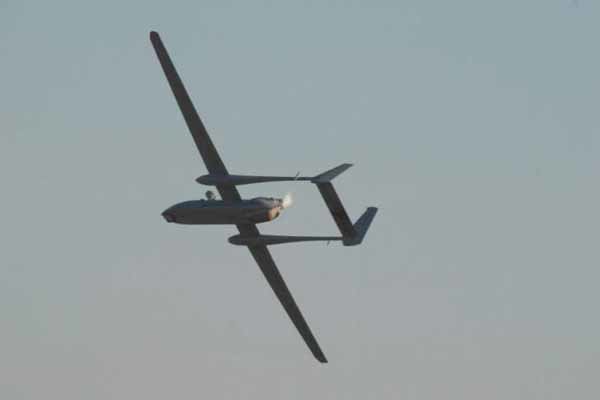Russia has inflicted serious damage on Ukrainian forces with recently introduced Iranian drones, in its first wide-scale deployment of a foreign weapons system since the war began, Ukrainian commanders say.
Over the past week, Shahed-136 delta-wing drones, repainted in Russian colors and rebranded as Geranium 2, started appearing over Ukrainian armor and artillery positions in the northeastern Kharkiv region, said Col. Rodion Kulagin, commander of artillery of Ukraine’s 92nd Mechanized Brigade.
In his brigade’s operational area alone, the Iranian drones—which usually fly in pairs and then slam into their targets—have destroyed two 152-mm self-propelled howitzers, two 122-mm self-propelled howitzers, as well as two BTR armored infantry vehicles, he said.
Before the current wide-scale use of the Shaheds, Russia carried out a test last month, striking a U.S.-supplied M777 155-mm towed howitzer with the drone, Col. Kulagin said. Another Iranian drone malfunctioned and was recovered, he said.
So far, the Iranian drones seem to have been mostly deployed in the Kharkiv region, where the 92nd Brigade and other Ukrainian forces carried out a major offensive this month, retaking some 8,500 square kilometers, or roughly 3,300 square miles, of land occupied by Russia and seizing or destroying hundreds of Russian tanks, artillery pieces and armored carriers.
“In other areas, the Russians have overwhelming artillery firepower, and they manage with that. Here, they no longer have that artillery advantage, and so they have started to resort to these drones,” Col. Kulagin said.
Independent experts who examined photographs of recent drone wreckage from the Kharkiv region say that it appears to be Shahed-136, the latest evolution of Tehran’s delta-wing design.
Scott Crino, founder and chief executive of Red Six Solutions LLC, a strategic consulting firm, said the Shahed-136 could provide Russia with a “potent counterweight” to the high-tech weapons systems, such as Himars missile launchers, that the U.S. has provided to Ukraine.

Ukrainian servicemen repair a captured Russian tank in the Kharkiv region.PHOTO: OLEG PETRASYUK/SHUTTERSTOCK
“The presence of Shahed-136 in Ukraine war is undoubtedly changing the operational plans of Kyiv,” he said. “The sheer size of Ukraine battlefield makes it hard to defend against the Shahed-136.”
Mr. Crino said the Shahed-136 can be used with great effect with one targeting a radar system and the second one hitting artillery pieces. Iran also has antijamming systems that can make it hard for Ukrainian forces to counter, he said. “Once a Shahed locks onto target, it will be hard to stop,” he said.
Russia’s use of Shahed-136 drones in Ukraine represents the most challenging expansion of Tehran’s arsenal beyond the Middle East, where Iran has successfully used its unmanned aerial vehicles to pressure America and its allies in the region. It also highlights the deficiencies in Russia’s own drone program, which hasn’t been able to match the firepower of armed UAVs deployed by Ukraine.
Israel and the West have accused Iran and its proxies of flying armed drones to attack Saudi Arabia’s oil industry, the capital of the United Arab Emirates, American soldiers in Syria, as well as tankers in the Gulf of Oman in recent years.
The British Ministry of Defense, in its intelligence update on Sept. 14, also said it was highly likely that Russia had deployed Iranian drones in Ukraine for the first time. Noting that the Shahed-136 has a claimed range of 2,500 kilometers, it added that so far, it appears that Moscow is using these drones for tactical strikes near front lines rather than to destroy more strategic targets deep into Ukrainian territory.
The Iranian drones are relatively small and fly at a very low altitude, making it hard for Ukrainian air-defense systems to detect them, Col. Kulagin said. He said he hoped the U.S. and allies could provide Ukraine with more advanced antidrone technologies, or would step in to disrupt Iranian drone shipments to Russia.
In July, U.S. national security adviser Jake Sullivan warned that Russian defense officials had visited Iran, preparing to purchase up to several hundred Iranian drones, including the weapons-capable ones, on an expedited timeline. At the time, Iran’s Foreign Minister Hossein Amir-Abdollahian denied the plan in a phone call with his Ukrainian counterpart and said that Tehran opposed the war on Ukraine, according to a statement by the Iranian Foreign Ministry.
Russia hasn’t publicly commented on Iranian drone purchases. Iran’s Foreign Ministry didn’t respond to a recent Wall Street Journal request to comment on the matter. The Kremlin and the Russian Defense Ministry didn’t immediately respond to requests for comment.
On Sept. 8, the U.S. Department of the Treasury said it had sanctioned Iranian company Safiran Airport Services for coordinating Russian military flights that transported Iranian drones and related equipment to Russia, and Iranian drone-manufacturing companies Paravar Pars, DAMA and Baharestan Kish.Advertisement – Scroll to Continue
Drones of different kinds play an important role in the Ukrainian conflict, in part because neither side has air superiority and is, therefore, reluctant to use manned aircraft over enemy positions. Hundreds of military and commercial reconnaissance drones hover in the air daily along the front lines, spotting targets and guiding artillery fire.
Ukraine, unlike Russia, also operates a fleet of drones armed with missiles. These Turkish-made Bayraktar TB2 drones destroyed several Russian armored columns in the early days of the war and are being used more frequently once again, now that Kyiv has been able to weaken Russian air defenses in many areas, in part thanks to U.S.-supplied AGM-88 HARM antiradar missiles.

The U.S. accused Iran of using delta-wing drones as part of a coordinated 2019 attack on Saudi Arabia’s oil facilities, including in Jeddah.PHOTO: ANDREJ ISAKOVIC/AGENCE FRANCE-PRESSE/GETTY IMAGES
Both Russia and Ukraine also use what are known as kamikaze drones, or loitering munitions. Russia’s Kalashnikov Group has developed a homemade drone known as Kub-Bla, while Ukraine is flying Polish-made Warmate and U.S.-supplied Switchblade drones, as well as some locally made UAVs. These munitions have a much shorter range and flying time than the Iranian-developed Shahed drones, and carry a significantly smaller payload.
Iran has emerged as one of the world’s most resourceful developers of combat drones, in part by reverse-engineering American drones that went astray over the past two decades in Iraq and Afghanistan.
Since Iran unveiled its kamikaze drones in 2016, versions of them have been used to carry out attacks across the Middle East. Last year, the British government accused Iran of using Shahed-136 drones to strike an Israeli-affiliated oil tanker off the coast of Oman, in an incident that killed two crew members. A U.S. military investigation recovered drone debris from the MT Mercer Street tanker and concluded that these were parts of Iranian made delta-wing drones.
Washington also accused Iran of using delta-wing drones as part of a coordinated 2019 attack on Saudi Arabia’s oil industry.
The U.S. and Israel have accused Iran of providing militants everywhere from Yemen to Lebanon with the training and the parts they need to develop their own drones.
Iran-backed Houthi forces in Yemen have repeatedly used delta-wing drones to carry out attacks on neighboring Saudi Arabia. In February, Israeli officials said, U.S. jet fighters brought down two Iranian delta-wing drones over northern Iraq. Israeli officials said the drones were heading for Israel.
While the Biden administration has been warning for months that Iran was preparing to provide Russia with hundreds of drones to use in Ukraine, the U.S. initially expected Tehran to have shipped drones capable of carrying missiles, not the kamikaze-style Shaheds.
Michael Knights, a military specialist at the Washington Institute for Near East Policy, a think tank, predicted that Ukrainian forces would be able to quickly counter the threat posed by Iranian kamikaze drones. “Iran’s drones look snazzy in Yemen and Syria and Gaza, but they’re increasingly blockable,” he said.
Ukraine, he said, is “a serious counter-air environment and electronic warfare environment that Iran hasn’t really experienced before.” These drones, Mr. Knights added, “tend to have effect at first and then the shock effect wears off.”
Yaroslav Trofimov and Dion Nissenbaum
Source: WSJ



